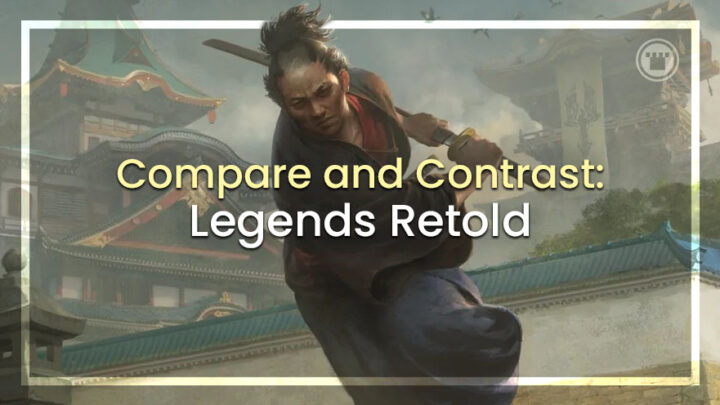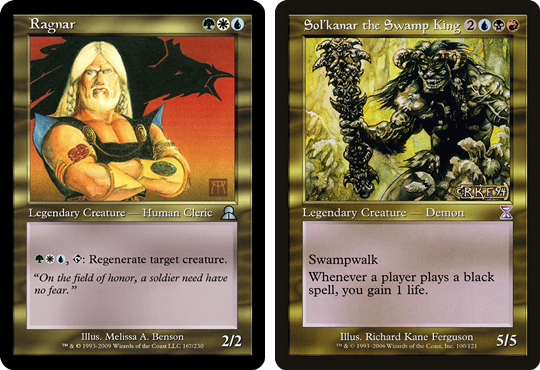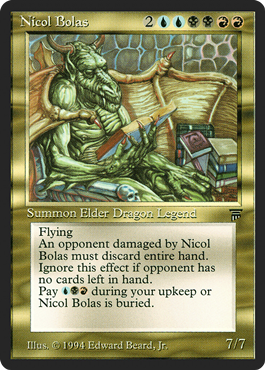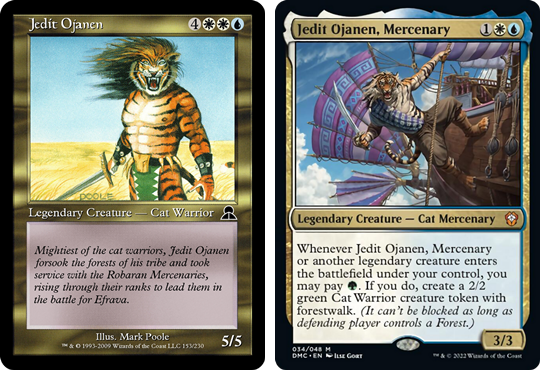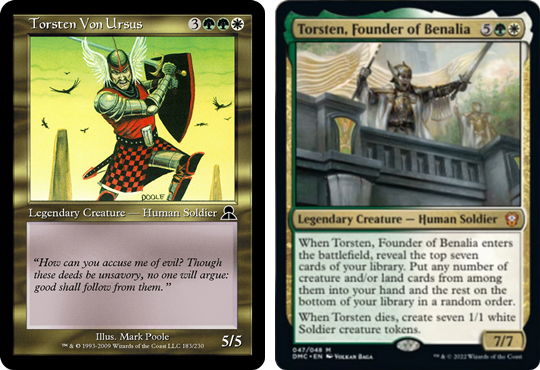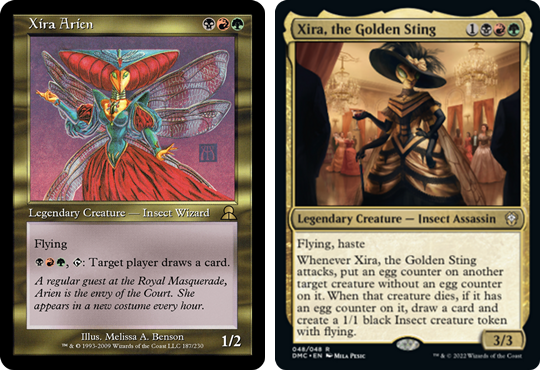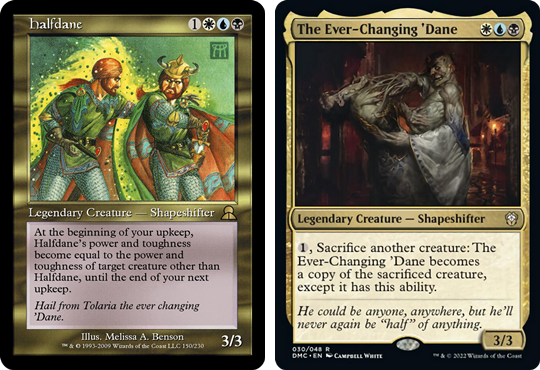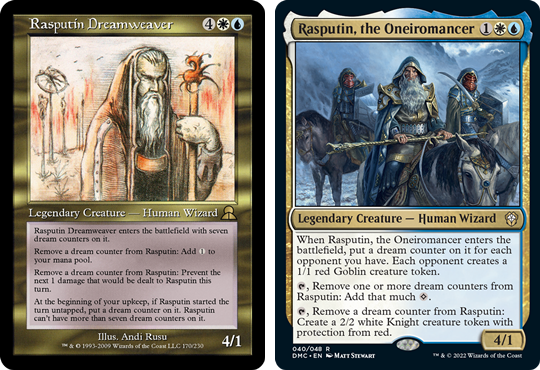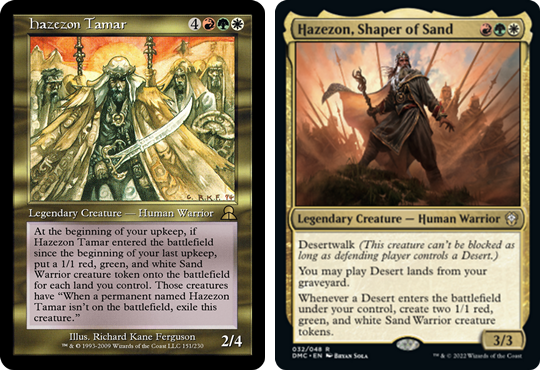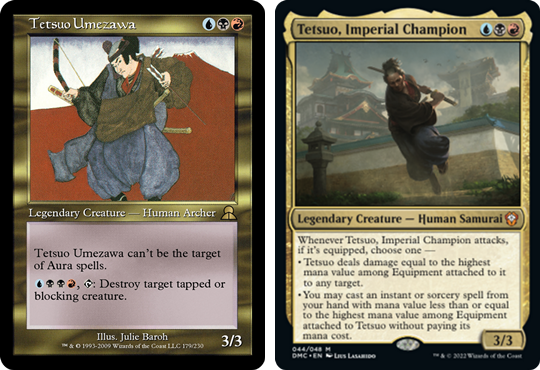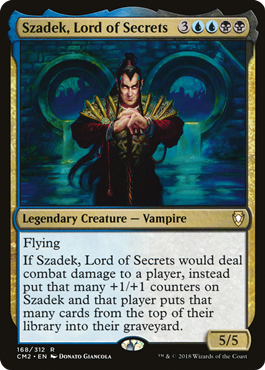Dominaria United preview season is officially over, and as expected when returning to the original home plane of Magic, Wizards of the Coast served us a full portion of nostalgia. While the new storyline with Phyrexia is quite reminiscent of (and full of callbacks to) Invasion, there’s an even deeper layer of references to MTG history with the Legends Retold box-toppers.
Infamous and beloved in equal measure, Legends introduced players to the first ever multicolored cards and legendary creatures. Novice company outsiders created many of these iconic cards with minimal input from Wizard’s main design team, leading to a loose approach to both game balance and color pie theory. This instantly set these cards apart from other sets.
The designers were equally unaware of the Dominaria setting being developed for Antiquities. So, the original legendary creatures — a whopping 55 of them — drew inspiration from the designers’ own Dungeons & Dragons games.
Presented with no context beyond names and a snippet of flavor text and illustrated in a wild mix of styles, these eponymous Legends were a complete enigma to the players opening booster packs. However, this lack of detail only fueled their mystique, inviting players to imagine for themselves what stories lay behind epic names like Dakkon Blackblade… or Nicol Bolas.
As you might deduce, many of these characters were popular enough to be officially reintroduced as part of Magic’s ever-growing, narrative canon. Yet not all of them were lucky enough to receive an updated representation on actual cards — until now.
LEGENDS RETOLD
Wizards of the Coast veteran Ethan Fleischer and his team have lovingly re-imagined these cult classics, which will be printed as supplemental cards alongside Dominaria United. While not legal for Standard, Pioneer or Modern, they look incredibly exciting for modern-day Commander builds. They also manage to cleverly expand on the concepts and story of the originals.
Personally, I love that Wizards decided to go down this route instead of simply reprinting the actual cards from Legends as fancy showcase-style collectables. Janky design is part of the charm of Legends, but it’s nice that fans of these characters can now play them in a form which makes sense at a modern Commander table.
Even for the few OGs that still hold up, like Tetsuo Umezawa or Hazezon Tamar, these “Legends Retold” versions help build the legacy of their name and provide synergistic options to play in the 99 of their Legends incarnation, or vice versa.
HELP YOUR (OTHER) SELF
Getting new and powerful cards printed for your favorite character is a good problem to have, but it does force Commander players to choose which version will lead their deck into the future. Many Legends Retold cards have fleshed out distinct mechanical identities from some very bland, original designs.
In most of these cases, where the Legends version is just a vanilla (or French-vanilla) creature with a fancy name, I would recommend embracing the newer, more dynamic card as your commander choice. By all means, keep the original in the deck for nostalgia value!
But as much as I can make objective statements on “fun,” I think 99% of players will ultimately prefer a commander that has a tangible presence in-game over one that is mostly nice to look at. On the other hand, the more dynamic, original Legends give us some really interesting old/new deck building options.
Xira, the Golden Sting sports a more Jund-appropriate version of the original Xira Arien’s draw ability. You do need to kill implanted creatures to see maximum value, and that can include your own. So this version of the commander could look to play an aristocrats-style aggro deck — something Jund is great at doing.
You could also plan on “implanting” opposing creatures to help fuel a grindy, removal heavy deck list — but in that case I would actually recommend sticking with Xira Arien as commander since she has the more reliable card draw. Just include the new version as a complementary value engine.
Which version of Halfdane you run could quite possibly come down to how you feel about the gnarly body horror of his new art. But for those who can stomach it, the choice comes down to whether you want to exploit the stat lines of other creatures or their actual abilities.
In the former case, Legends Halfdane is still excellent for getting huge for free — even off opposing creatures — and it can easily threaten lethal commander damage. While he can also play for big stats, The Ever-Changing ‘Dane will be defined by the possibilities of morphing his rules text, ala Scion of the Ur-Dragon. I can imagine a fun build with lots of Mind Control effects to steal opposing abilities, but the competitive choice is probably creature-heavy and combo-centric.
Rasputin Dreamweaver mostly interests me from a history-of-design standpoint (does he not feel like a proto-planeswalker?), but there’s still some cool interplay on both sides of the partnership with his Retold version. If you keep the expensive Rasputin as your commander, the new one can immediately ramp into it with his impressive burst of mana generation.
I’d argue 2022 Rasputin offers the more exciting use for dream counters with his knight-creating ability, but he does lack an in-built way to generate more after hitting the table. The solution: play the original Dreamweaver in your 99 and include a few counter-moving effects so you can use him as a dream battery.
Hazezon Tamar probably holds up the best of any Legends commander in the modern meta. The sheer amount of tokens he can generate, especially with a cheap flicker effect right after he’s cast, more than justifies his hefty mana cost. Being able to make additional tokens with similar types and colors is all the justification I need to throw Hazezon, Shaper of Sand into that deck.
However, I’d also be excited to reverse their roles and see how the deck feels with a landfall theme on top of the flicker and go-wide aspects. Many deserts have powerful sacrifice effects, and looping Shefet Dunes or Ramunap Ruins to grow my army sounds powerful and fun.
Better yet, many of the strongest landfall effects in Naya colors are also token generators, so you could potentially go all the way down that route if the usual flicker tricks feel too pedestrian.
Finally, there’s Tetsuo, Imperial Champion — a.k.a Tetsuo Umezawa, descendant of Kamigawa’s Toshiro ( of Jitte fame) and ancestor of the planar fugitive Tetsuko. Linking spellcasting and swordsmanship seems to be the family schtick, and Tetsuo’s new card offers a good enough incentive to play some choice bits of equipment in an otherwise instant-heavy tempo/control list.
If you don’t mind being more dependent on your commander, I can easily see this Tetsuo leading a full-fledged equipment deck. While it lacks the kind of direct support you see in white, Wizards keeps on printing really nice Grixis-colored equipment — and you can still play all the generic artifact synergy cards available through this identity.
Perhaps, then, the controlling version of the deck is best off sticking with Legends Tetsuo in command, especially against creature decks. You can always include mana-efficient equipment like Pact Weapon or Nightmare Lash to get some options going when you draw the Imperial Champion version of him. However, being able to hold up that unconditional destroy ability against potential attackers is just too perfect to pass up in control.
LEGENDS FOR A NEW AGE
That so many of these Legends Retold cards can sit comfortably alongside their original versions (without fully superseding them) is a real testament to their design. Reading the comments from Ethan Fleischer and other Wizards staff makes it clear that genuine love for the Legends set and its accompanying novels fueled this project. And who among us wouldn’t dream of coming up with just the right reimagining of some past favorite cards, given the chance?
But beyond their value to nostalgic Magic veterans, these cards are a gift to generations of players who weren’t around to experience Legends in its own time. A fancied-up run of reprints with fresh, full-art depictions would have meant a lot to lifelong fans of Jasmine Boreal or Marhault Elsdragon. But with a design upgrade to put them on par with 2022 standards, they’ll be able to win over all-new fans with memorable in-game performance.
We’re in an era where blatant nostalgia runs rampant in media, to the point that our love for these brands can feel worn out or exploited. But that’s because loyalty to a story or character is earned, and while happy memories can let us coast along for a while, fresh glory is needed to keep their legends alive.
These box toppers are poised to take Commander by storm — and thereby keep these much-loved Magic characters in the hearts of the playerbase. But which legend are you most looking forward to playing in all its new found glory? Let me know on Twitter!

Tom’s fate was sealed in 7th grade when his friend lent him a pile of commons to play Magic. He quickly picked up Boros and Orzhov decks in Ravnica block and has remained a staunch white magician ever since. A fan of all Constructed formats, he enjoys studying the history of the tournament meta. He specializes in midrange decks, especially Death & Taxes and Martyr Proc. One day, he swears he will win an MCQ with Evershrike. Ask him how at @AWanderingBard, or watch him stream Magic at twitch.tv/TheWanderingBard.

